2013 FORD FIESTA airbag
[x] Cancel search: airbagPage 47 of 341
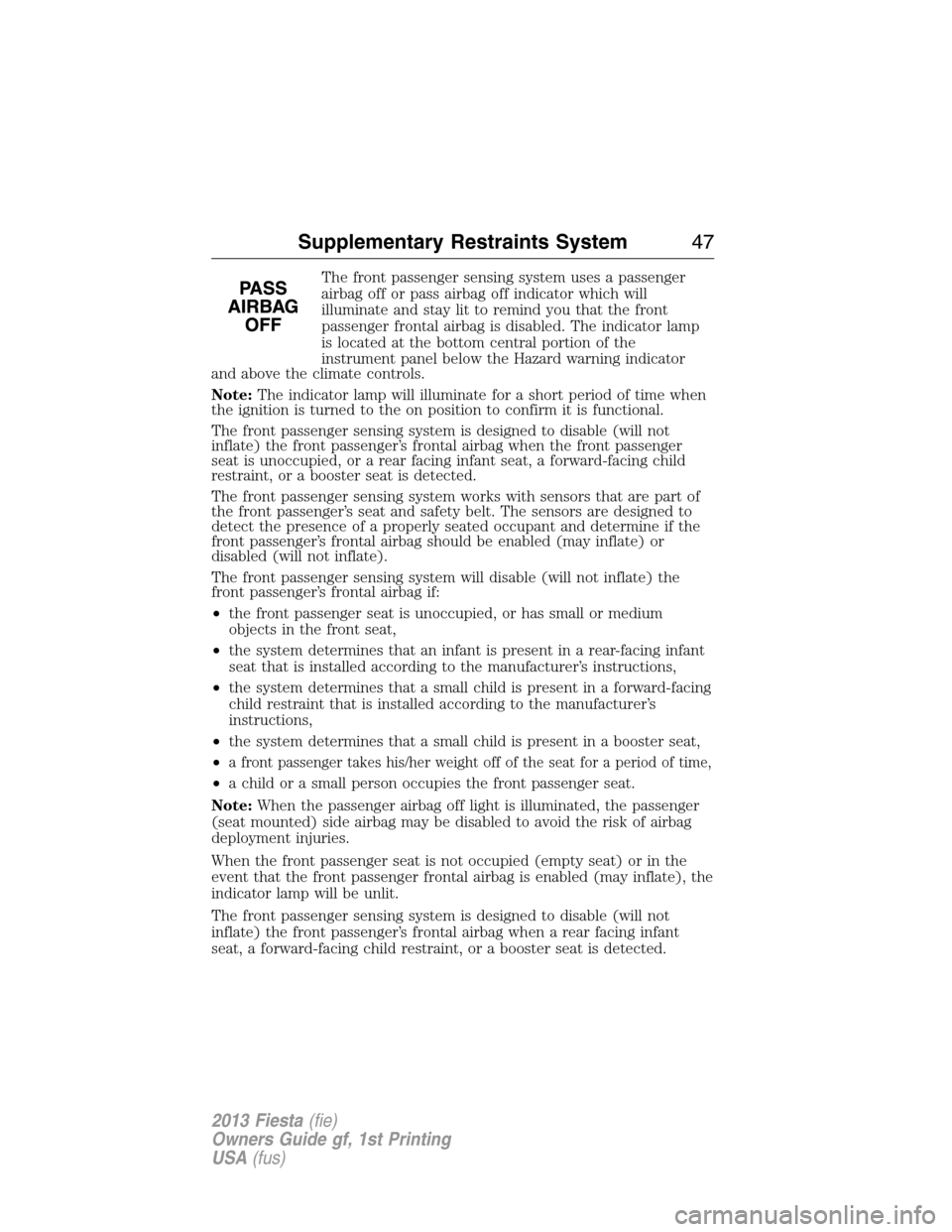
The front passenger sensing system uses a passenger
airbag off or pass airbag off indicator which will
illuminate and stay lit to remind you that the front
passenger frontal airbag is disabled. The indicator lamp
is located at the bottom central portion of the
instrument panel below the Hazard warning indicator
and above the climate controls.
Note:The indicator lamp will illuminate for a short period of time when
the ignition is turned to the on position to confirm it is functional.
The front passenger sensing system is designed to disable (will not
inflate) the front passenger’s frontal airbag when the front passenger
seat is unoccupied, or a rear facing infant seat, a forward-facing child
restraint, or a booster seat is detected.
The front passenger sensing system works with sensors that are part of
the front passenger’s seat and safety belt. The sensors are designed to
detect the presence of a properly seated occupant and determine if the
front passenger’s frontal airbag should be enabled (may inflate) or
disabled (will not inflate).
The front passenger sensing system will disable (will not inflate) the
front passenger’s frontal airbag if:
•the front passenger seat is unoccupied, or has small or medium
objects in the front seat,
•the system determines that an infant is present in a rear-facing infant
seat that is installed according to the manufacturer’s instructions,
•the system determines that a small child is present in a forward-facing
child restraint that is installed according to the manufacturer’s
instructions,
•the system determines that a small child is present in a booster seat,
•
a front passenger takes his/her weight off of the seat for a period of time,
•a child or a small person occupies the front passenger seat.
Note:When the passenger airbag off light is illuminated, the passenger
(seat mounted) side airbag may be disabled to avoid the risk of airbag
deployment injuries.
When the front passenger seat is not occupied (empty seat) or in the
event that the front passenger frontal airbag is enabled (may inflate), the
indicator lamp will be unlit.
The front passenger sensing system is designed to disable (will not
inflate) the front passenger’s frontal airbag when a rear facing infant
seat, a forward-facing child restraint, or a booster seat is detected.
Supplementary Restraints System47
2013 Fiesta(fie)
Owners Guide gf, 1st Printing
USA(fus)
Page 48 of 341
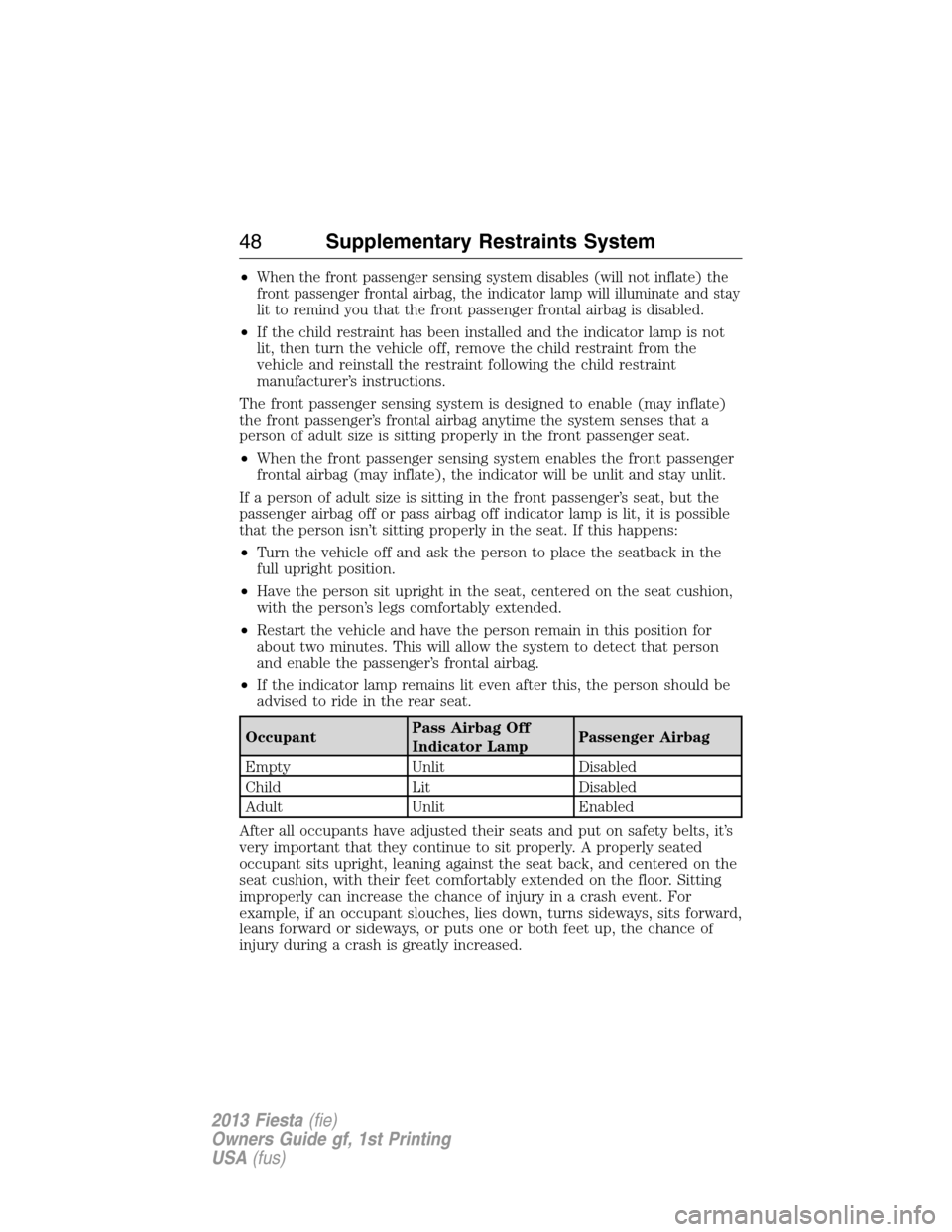
•When the front passenger sensing system disables (will not inflate) the
front passenger frontal airbag, the indicator lamp will illuminate and stay
lit to remind you that the front passenger frontal airbag is disabled.
•If the child restraint has been installed and the indicator lamp is not
lit, then turn the vehicle off, remove the child restraint from the
vehicle and reinstall the restraint following the child restraint
manufacturer’s instructions.
The front passenger sensing system is designed to enable (may inflate)
the front passenger’s frontal airbag anytime the system senses that a
person of adult size is sitting properly in the front passenger seat.
•When the front passenger sensing system enables the front passenger
frontal airbag (may inflate), the indicator will be unlit and stay unlit.
If a person of adult size is sitting in the front passenger’s seat, but the
passenger airbag off or pass airbag off indicator lamp is lit, it is possible
that the person isn’t sitting properly in the seat. If this happens:
•Turn the vehicle off and ask the person to place the seatback in the
full upright position.
•Have the person sit upright in the seat, centered on the seat cushion,
with the person’s legs comfortably extended.
•Restart the vehicle and have the person remain in this position for
about two minutes. This will allow the system to detect that person
and enable the passenger’s frontal airbag.
•If the indicator lamp remains lit even after this, the person should be
advised to ride in the rear seat.
OccupantPass Airbag Off
Indicator LampPassenger Airbag
Empty Unlit Disabled
Child Lit Disabled
Adult Unlit Enabled
After all occupants have adjusted their seats and put on safety belts, it’s
very important that they continue to sit properly. A properly seated
occupant sits upright, leaning against the seat back, and centered on the
seat cushion, with their feet comfortably extended on the floor. Sitting
improperly can increase the chance of injury in a crash event. For
example, if an occupant slouches, lies down, turns sideways, sits forward,
leans forward or sideways, or puts one or both feet up, the chance of
injury during a crash is greatly increased.
48Supplementary Restraints System
2013 Fiesta(fie)
Owners Guide gf, 1st Printing
USA(fus)
Page 49 of 341
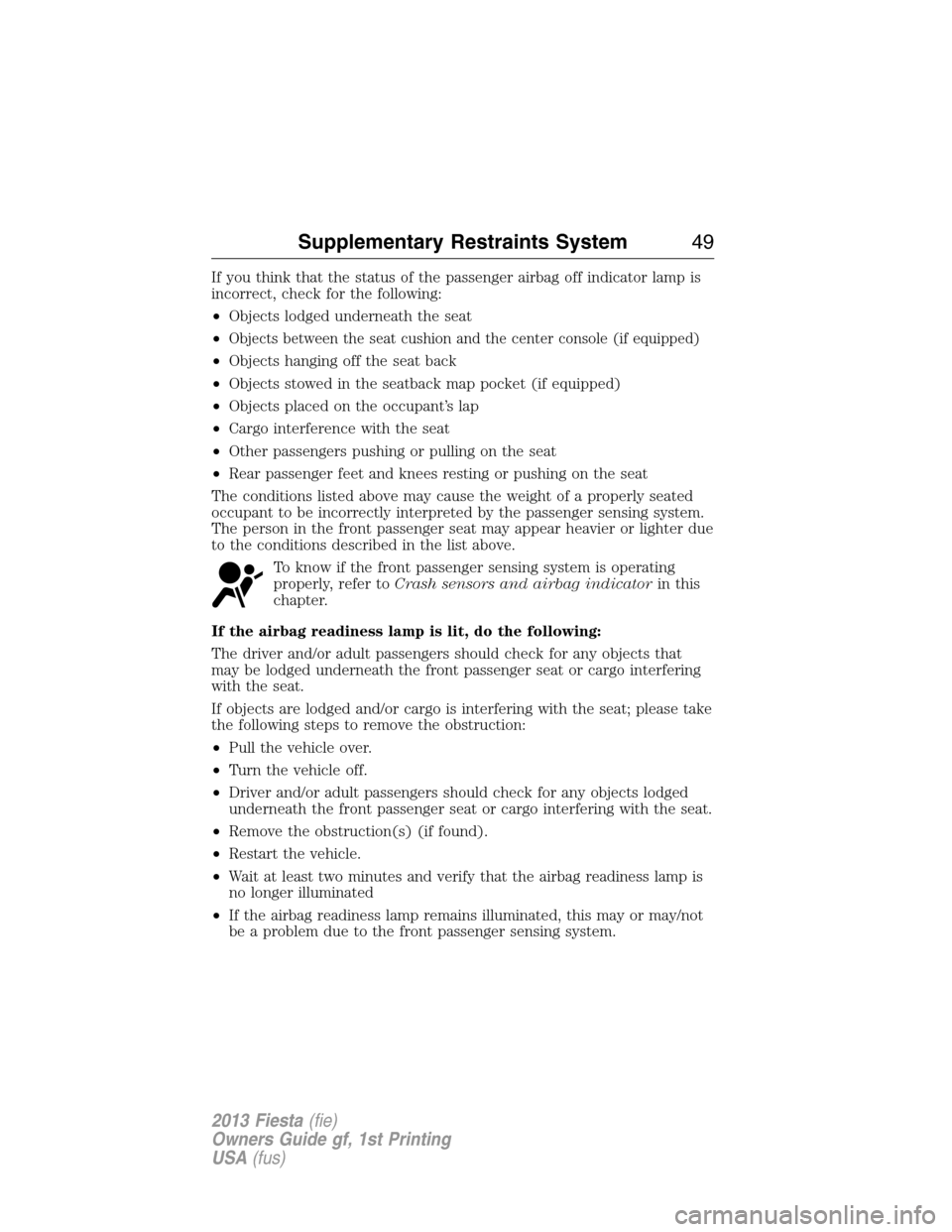
If you think that the status of the passenger airbag off indicator lamp is
incorrect, check for the following:
•Objects lodged underneath the seat
•
Objects between the seat cushion and the center console (if equipped)
•Objects hanging off the seat back
•Objects stowed in the seatback map pocket (if equipped)
•Objects placed on the occupant’s lap
•Cargo interference with the seat
•Other passengers pushing or pulling on the seat
•Rear passenger feet and knees resting or pushing on the seat
The conditions listed above may cause the weight of a properly seated
occupant to be incorrectly interpreted by the passenger sensing system.
The person in the front passenger seat may appear heavier or lighter due
to the conditions described in the list above.
To know if the front passenger sensing system is operating
properly, refer toCrash sensors and airbag indicatorin this
chapter.
If the airbag readiness lamp is lit, do the following:
The driver and/or adult passengers should check for any objects that
may be lodged underneath the front passenger seat or cargo interfering
with the seat.
If objects are lodged and/or cargo is interfering with the seat; please take
the following steps to remove the obstruction:
•Pull the vehicle over.
•Turn the vehicle off.
•Driver and/or adult passengers should check for any objects lodged
underneath the front passenger seat or cargo interfering with the seat.
•Remove the obstruction(s) (if found).
•Restart the vehicle.
•Wait at least two minutes and verify that the airbag readiness lamp is
no longer illuminated
•If the airbag readiness lamp remains illuminated, this may or may/not
be a problem due to the front passenger sensing system.
Supplementary Restraints System49
2013 Fiesta(fie)
Owners Guide gf, 1st Printing
USA(fus)
Page 50 of 341

DO NOT attempt to repair or service the system; take your vehicle
immediately to an authorized dealer.
If it is necessary to modify an advanced front airbag system to
accommodate a person with disabilities, contact the Ford Customer
Relationship Center at the phone number shown in theCustomer
Assistancesection of this owner’s guide.
SIDE AIRBAGS
WARNING:Do not place objects or mount equipment on or near
the airbag cover, on the side of the seatbacks (of the front seats),
or in front seat areas that may come into contact with a deploying
airbag. Failure to follow these instructions may increase the risk of
personal injury in the event of a collision.
WARNING:Do not use accessory seat covers. The use of
accessory seat covers may prevent the deployment of the side
airbags and increase the risk of injury in an accident.
WARNING:Do not lean your head on the door. The side airbag
could injure you as it deploys from the side of the seatback.
WARNING:Do not attempt to service, repair, or modify the
airbag, its fuses or the seat cover on a seat containing an airbag.
Contact your authorized dealer as soon as possible.
WARNING:If the side airbag has deployed,the airbag will not
function again. The side airbag system (including the seat)
must be inspected and serviced by an authorized dealer.If the
airbag is not replaced, the unrepaired area will increase the risk of
injury in a collision.
The side airbags are fitted on the outboard side of the seatbacks of the
front seats. In certain lateral collisions, the airbag on the side affected by
the collision will be inflated. The airbag was designed to inflate between
the door panel and occupant to further enhance the protection provided
occupants in side impact collisions.
50Supplementary Restraints System
2013 Fiesta(fie)
Owners Guide gf, 1st Printing
USA(fus)
Page 51 of 341
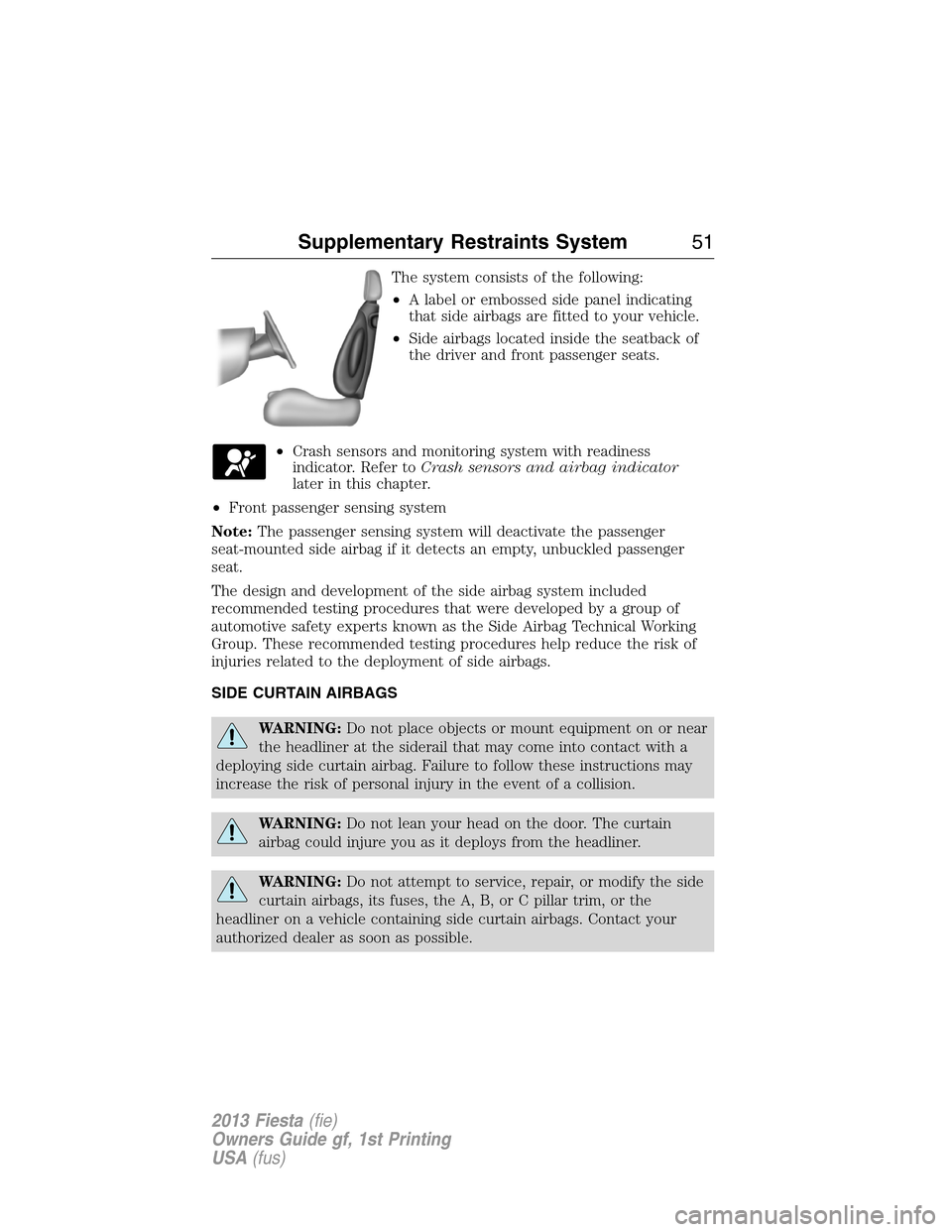
The system consists of the following:
•A label or embossed side panel indicating
that side airbags are fitted to your vehicle.
•Side airbags located inside the seatback of
the driver and front passenger seats.
•Crash sensors and monitoring system with readiness
indicator. Refer toCrash sensors and airbag indicator
later in this chapter.
•Front passenger sensing system
Note:The passenger sensing system will deactivate the passenger
seat-mounted side airbag if it detects an empty, unbuckled passenger
seat.
The design and development of the side airbag system included
recommended testing procedures that were developed by a group of
automotive safety experts known as the Side Airbag Technical Working
Group. These recommended testing procedures help reduce the risk of
injuries related to the deployment of side airbags.
SIDE CURTAIN AIRBAGS
WARNING:Do not place objects or mount equipment on or near
the headliner at the siderail that may come into contact with a
deploying side curtain airbag. Failure to follow these instructions may
increase the risk of personal injury in the event of a collision.
WARNING:Do not lean your head on the door. The curtain
airbag could injure you as it deploys from the headliner.
WARNING:Do not attempt to service, repair, or modify the side
curtain airbags, its fuses, the A, B, or C pillar trim, or the
headliner on a vehicle containing side curtain airbags. Contact your
authorized dealer as soon as possible.
Supplementary Restraints System51
2013 Fiesta(fie)
Owners Guide gf, 1st Printing
USA(fus)
Page 52 of 341
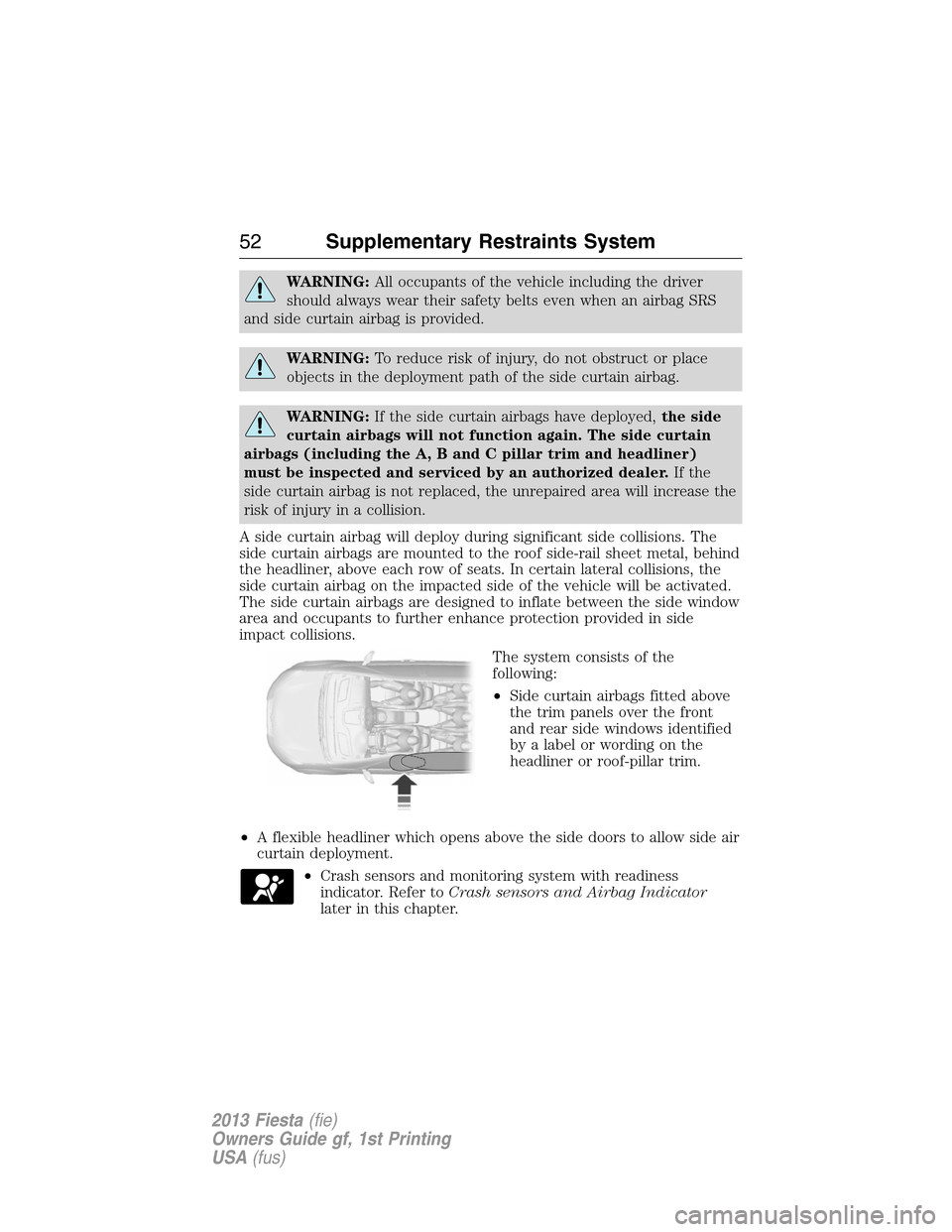
WARNING:All occupants of the vehicle including the driver
should always wear their safety belts even when an airbag SRS
and side curtain airbag is provided.
WARNING:To reduce risk of injury, do not obstruct or place
objects in the deployment path of the side curtain airbag.
WARNING:If the side curtain airbags have deployed,the side
curtain airbags will not function again. The side curtain
airbags (including the A, B and C pillar trim and headliner)
must be inspected and serviced by an authorized dealer.If the
side curtain airbag is not replaced, the unrepaired area will increase the
risk of injury in a collision.
A side curtain airbag will deploy during significant side collisions. The
side curtain airbags are mounted to the roof side-rail sheet metal, behind
the headliner, above each row of seats. In certain lateral collisions, the
side curtain airbag on the impacted side of the vehicle will be activated.
The side curtain airbags are designed to inflate between the side window
area and occupants to further enhance protection provided in side
impact collisions.
The system consists of the
following:
•Side curtain airbags fitted above
the trim panels over the front
and rear side windows identified
by a label or wording on the
headliner or roof-pillar trim.
•A flexible headliner which opens above the side doors to allow side air
curtain deployment.
•Crash sensors and monitoring system with readiness
indicator. Refer toCrash sensors and Airbag Indicator
later in this chapter.
52Supplementary Restraints System
2013 Fiesta(fie)
Owners Guide gf, 1st Printing
USA(fus)
Page 53 of 341
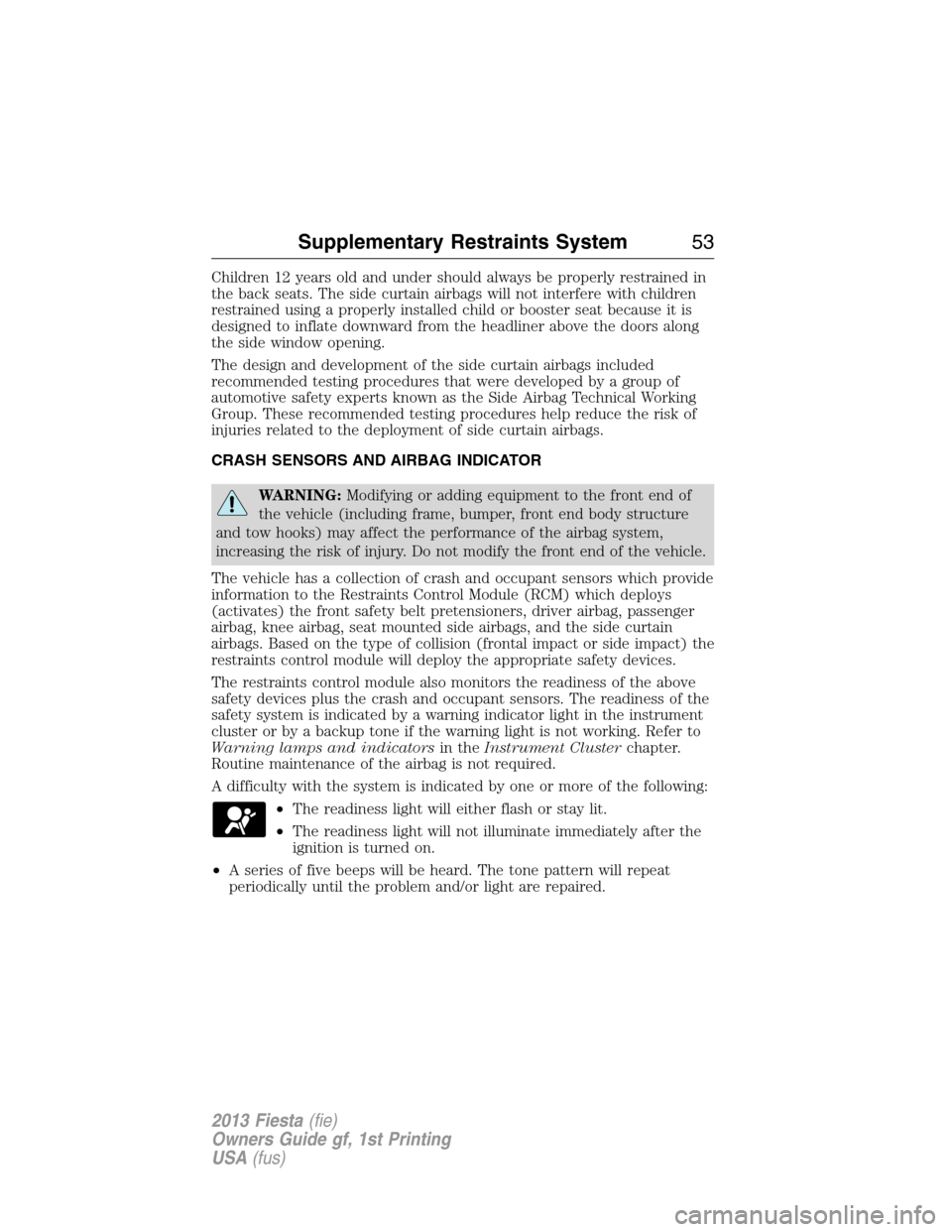
Children 12 years old and under should always be properly restrained in
the back seats. The side curtain airbags will not interfere with children
restrained using a properly installed child or booster seat because it is
designed to inflate downward from the headliner above the doors along
the side window opening.
The design and development of the side curtain airbags included
recommended testing procedures that were developed by a group of
automotive safety experts known as the Side Airbag Technical Working
Group. These recommended testing procedures help reduce the risk of
injuries related to the deployment of side curtain airbags.
CRASH SENSORS AND AIRBAG INDICATOR
WARNING:Modifying or adding equipment to the front end of
the vehicle (including frame, bumper, front end body structure
and tow hooks) may affect the performance of the airbag system,
increasing the risk of injury. Do not modify the front end of the vehicle.
The vehicle has a collection of crash and occupant sensors which provide
information to the Restraints Control Module (RCM) which deploys
(activates) the front safety belt pretensioners, driver airbag, passenger
airbag, knee airbag, seat mounted side airbags, and the side curtain
airbags. Based on the type of collision (frontal impact or side impact) the
restraints control module will deploy the appropriate safety devices.
The restraints control module also monitors the readiness of the above
safety devices plus the crash and occupant sensors. The readiness of the
safety system is indicated by a warning indicator light in the instrument
cluster or by a backup tone if the warning light is not working. Refer to
Warning lamps and indicatorsin theInstrument Clusterchapter.
Routine maintenance of the airbag is not required.
A difficulty with the system is indicated by one or more of the following:
•The readiness light will either flash or stay lit.
•The readiness light will not illuminate immediately after the
ignition is turned on.
•A series of five beeps will be heard. The tone pattern will repeat
periodically until the problem and/or light are repaired.
Supplementary Restraints System53
2013 Fiesta(fie)
Owners Guide gf, 1st Printing
USA(fus)
Page 54 of 341
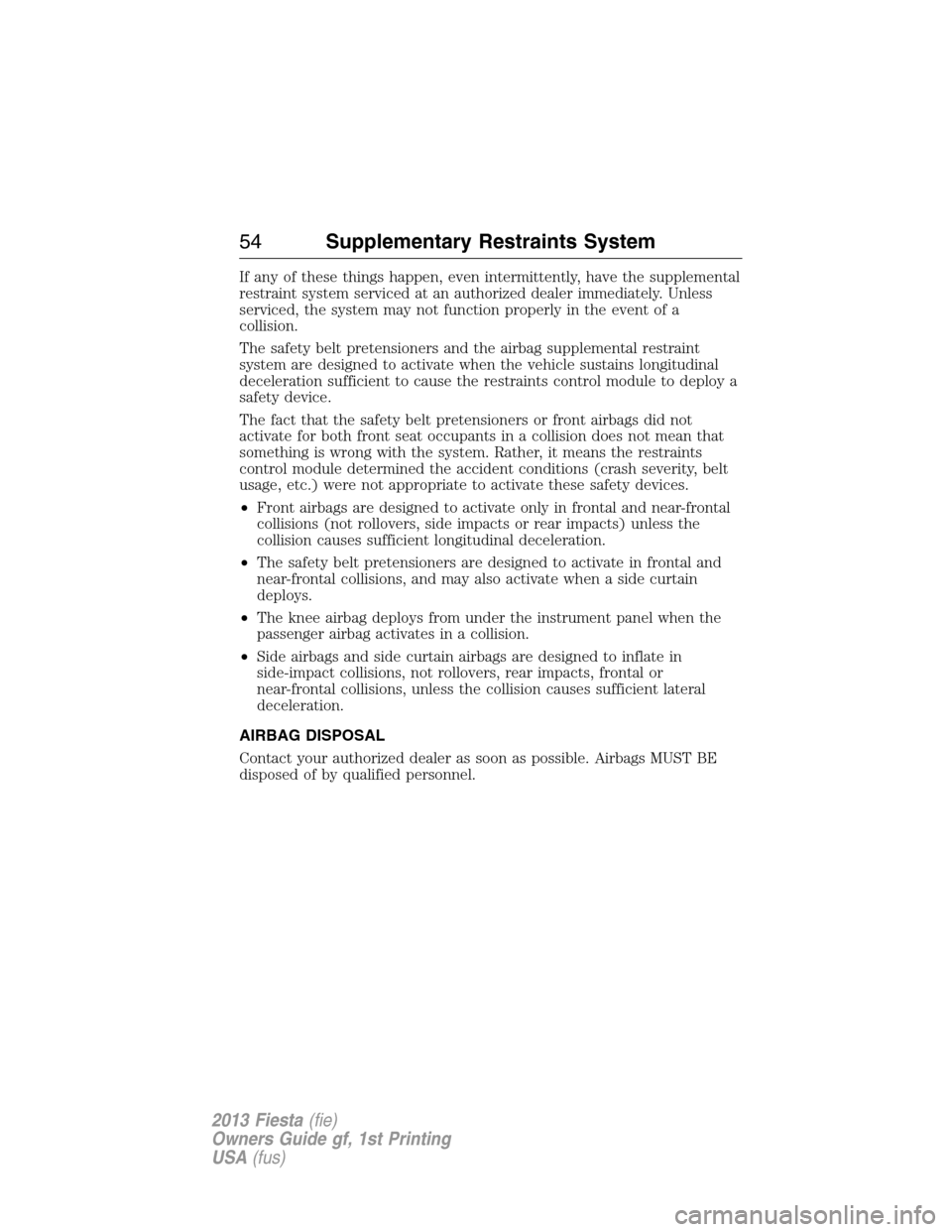
If any of these things happen, even intermittently, have the supplemental
restraint system serviced at an authorized dealer immediately. Unless
serviced, the system may not function properly in the event of a
collision.
The safety belt pretensioners and the airbag supplemental restraint
system are designed to activate when the vehicle sustains longitudinal
deceleration sufficient to cause the restraints control module to deploy a
safety device.
The fact that the safety belt pretensioners or front airbags did not
activate for both front seat occupants in a collision does not mean that
something is wrong with the system. Rather, it means the restraints
control module determined the accident conditions (crash severity, belt
usage, etc.) were not appropriate to activate these safety devices.
•Front airbags are designed to activate only in frontal and near-frontal
collisions (not rollovers, side impacts or rear impacts) unless the
collision causes sufficient longitudinal deceleration.
•The safety belt pretensioners are designed to activate in frontal and
near-frontal collisions, and may also activate when a side curtain
deploys.
•The knee airbag deploys from under the instrument panel when the
passenger airbag activates in a collision.
•Side airbags and side curtain airbags are designed to inflate in
side-impact collisions, not rollovers, rear impacts, frontal or
near-frontal collisions, unless the collision causes sufficient lateral
deceleration.
AIRBAG DISPOSAL
Contact your authorized dealer as soon as possible. Airbags MUST BE
disposed of by qualified personnel.
54Supplementary Restraints System
2013 Fiesta(fie)
Owners Guide gf, 1st Printing
USA(fus)